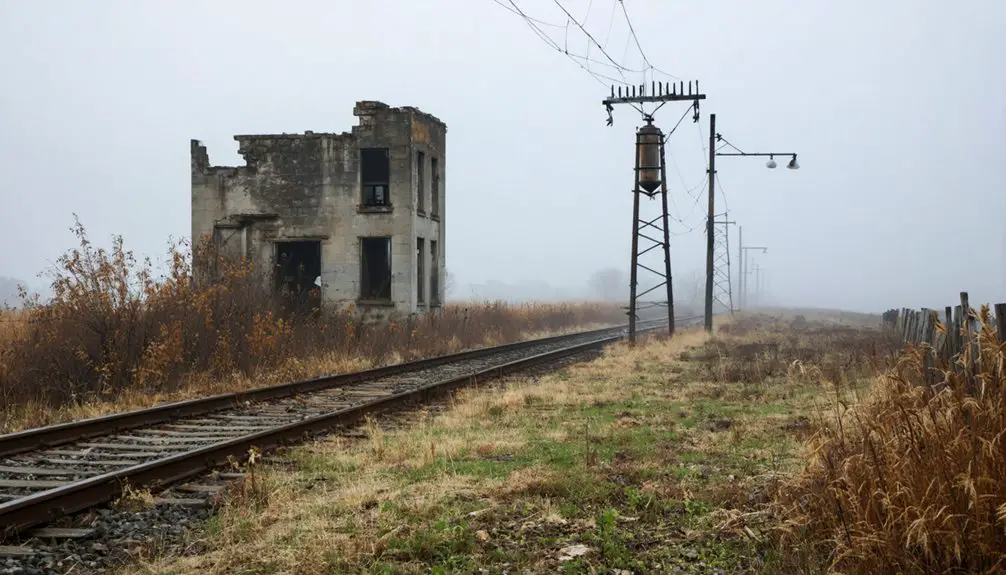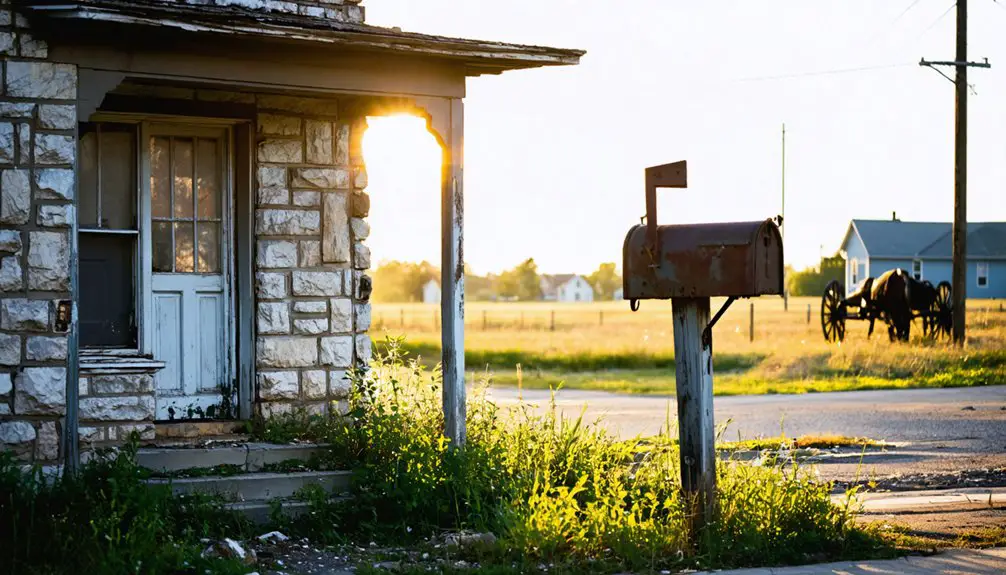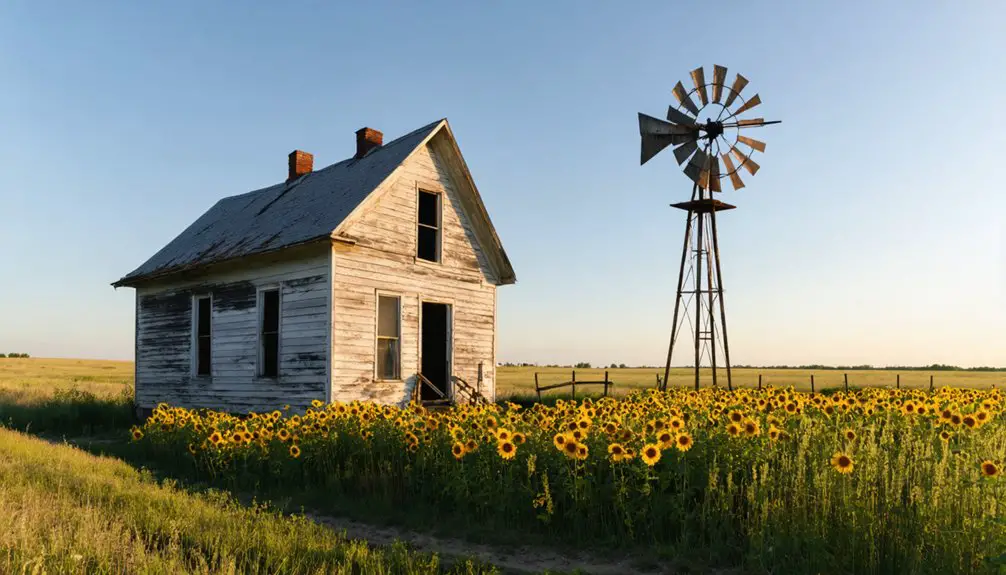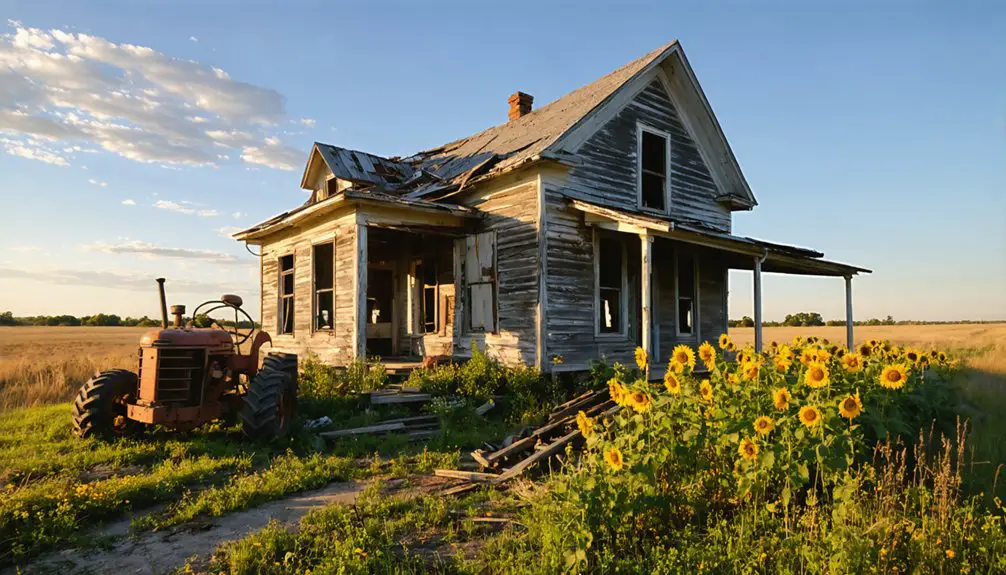You’ll find Auburndale’s ghost town roots in its 1888 founding as Sherburn, a railroad-connected settlement during Kansas’s westward expansion. The town maintained a population of around 60 residents at its peak, with life centered around agriculture and rail commerce. While its post office closed in 1899, Auburndale’s story mirrors many Kansas railroad towns that declined through agricultural mechanization and the Great Depression. The preserved archives and historical records hold fascinating details about this vanished frontier community.
Key Takeaways
- Established in 1888 as Sherburn, Auburndale was a Kansas railroad town that experienced steady population decline over several decades.
- The town’s post office operated until 1927, with its closure marking a significant milestone in the community’s decline.
- Economic factors including agricultural mechanization, the Great Depression, and urban migration led to Auburndale’s eventual abandonment.
- No frontier-era buildings remain today, though historical records document the town’s limestone and locally-sourced brick architecture.
- The Shawnee County Historical Society maintains community archives and supports preservation efforts through a historical park initiative.
Origins and Early Settlement (1888-1899)
The railroad boom of the 1880s brought Auburndale into existence, established around 1888 during Kansas’s westward expansion period. Initially named Sherburn after a railroad-connected resident, the settlement’s strategic location along active rail lines made it an attractive spot for pioneers seeking opportunity on the Kansas plains. Population declined steadily over several decades, mirroring the fate of many Kansas railroad towns.
Railroad influence shaped every aspect of early Auburndale’s development. Like the early Swedish immigrants who came to Sherman County, you’d have found a mix of railroad workers, entrepreneurs, and families settling in the community, with settlement patterns following the typical frontier town model.
The establishment of a post office formalized the town’s presence, while basic infrastructure emerged to serve the growing population. Early buildings included wooden structures housing essential services, and the community developed around communal gathering spots like churches and the post office.
Daily Life in Historical Auburndale
Life in early Auburndale centered around agriculture, with daily routines shaped by farming seasons and community cooperation. You’d find yourself rising with the sun to tend to crops and livestock, working alongside neighbors during vital planting and harvest times. Similar to nearby St. Marks Community, the population likely hovered around 60 residents during peak settlement years. Like other communities in the region, the town was established near railroad tracks, mirroring nearby towns.
Dawn-to-dusk farming and shared labor defined early Auburndale, where neighbors united to work the land and sustain their community.
Daily routines revolved around essential tasks, while social gatherings at churches and community halls provided much-needed connection.
Your typical activities would include:
- Working the fields from dawn to dusk, maintaining equipment at local blacksmith shops
- Attending church services and seasonal fairs for social interaction
- Walking or using horse-drawn transportation to visit the general store and post office
- Participating in community events and agricultural meetings to strengthen local bonds
Despite limited amenities and challenging weather conditions, you’d experience a strong sense of self-reliance and neighborly support.
The Post Office Era and Community Services
When you examine Auburndale’s postal history, you’ll find a federal post office that operated through the late 19th century until sometime after 1927, serving as the town’s primary communication hub.
The post office’s Romanesque-styled building, documented in the 1908 Souvenir, stood as one of Auburndale’s most notable structures while coordinating mail services and rural free delivery routes. According to historical records, the facility’s R.F.D. covers became sought-after collectibles among postal enthusiasts.
Beyond mail handling, the facility functioned as an essential community center where residents gathered to exchange news and conduct business, until the town’s eventual decline led to the discontinuation of postal services. Similar to many emerging towns of the era, Auburndale’s development was supported by the Atlantic Coast Line Railroad, which facilitated mail delivery and commerce in the region.
Post Office Operations Timeline
During Kansas’s westward expansion period, Auburndale’s post office emerged as an essential community hub, though its exact establishment date remains documented only in Baughman’s “Kansas Post Offices” reference guide.
You’ll find this postal service history followed typical patterns of rural Kansas development, with operations spanning from the late 19th or early 20th century until its eventual closure. Like several other post offices such as Brett which closed in 1882, Auburndale reflected the transient nature of frontier postal operations.
- Initial establishment required detailed site location reports submitted to the Post Office Department’s Topographer.
- Regular mail dispatch and receipt served both personal and business needs.
- Services expanded to include stamps, postal route maps, and possibly money orders.
- Operations continued until broader postal service consolidations and rural free delivery expansion led to its discontinuation, reflecting the changing landscape of Kansas’s postal network.
Community Hub Evolution
As Auburndale’s post office anchored the town’s daily operations, a network of essential services emerged to support its peak population of over 600 residents.
You’d find general stores serving as vibrant hubs of community interaction, where locals gathered to purchase supplies and exchange news. The town’s social dynamics revolved around churches and schools, which doubled as meeting spaces for various gatherings. Similar to Empire City’s population peak, the bustling community attracted thousands seeking economic opportunities.
The resource-based economy fueled a diverse mix of establishments including hotels, bars, and brothels. Without a formal police force, the community relied on informal governance structures and traveling doctors for basic services. Natural disasters contributed significantly to the town’s eventual decline.
As mining activity declined and natural disasters struck, these communal spaces gradually disappeared. Today, only a few historic structures remain as silent witnesses to Auburndale’s once-thriving community life.
Economic Factors Behind the Town’s Decline
The economic decline of Auburndale, Kansas followed a pattern common to many rural Kansas communities in the early-to-mid 20th century.
As rural migration to larger cities intensified, the town’s economic foundation began crumbling under multiple pressures that proved insurmountable for this small farming community.
Key factors that accelerated Auburndale’s decline:
- Agricultural mechanization drastically reduced local labor demands, allowing fewer farmers to work larger areas.
- The Great Depression devastated the town’s already fragile economy, forcing many businesses to close.
- A shrinking tax base made it impossible to maintain essential services and infrastructure.
- The economic pull of nearby cities drained away working-age residents, creating a downward spiral of decreased consumer spending and business closures.
The trend toward larger family farms contributed significantly to the town’s deterioration, as increasing debt for land and machinery forced many smaller operations to close or sell.
Transportation Networks and Their Impact

Transportation networks played a pivotal role in both Auburndale’s rise and eventual decline, mirroring patterns seen across rural Kansas during the late 19th and early 20th centuries.
You’ll find that Auburndale’s story reflects the broader transportation evolution that shaped Kansas towns – from its establishment near essential railroad lines to its eventual absorption into Topeka’s urban landscape.
The town’s initial growth stemmed from its strategic location along the railroad, which brought significant commerce and communication links.
However, as transportation systems modernized, with improved highways replacing rail dominance, you’d see a shift in population dynamics.
This urban migration pattern meant residents could easily commute to larger cities, ultimately leading to Auburndale’s shift from an independent town to a Topeka neighborhood.
Notable Buildings and Landmarks
If you’re searching for preserved historic structures in Auburndale, you’ll find that virtually no frontier-era buildings have survived the town’s decline since its post office closed in 1899.
While the agricultural landscape dominates the area today, any architectural remnants from Auburndale’s brief period of settlement would hold significant historical value for Shawnee County.
You’ll need to consult local historical societies and archives to uncover more specific details about the buildings that once stood in this Kansas ghost town, as current documentation of structures is extremely limited.
Preserved Historic Structures
Despite Auburndale’s decline into a ghost town, several historic structures remain scattered across Kansas’s vanished frontier communities.
While architectural styles from the 19th and early 20th centuries have largely disappeared, you’ll find remarkable examples of historic preservation throughout the region.
- Delos Johnson’s house in Rollin stands as a monument to frontier craftsmanship
- Shoal Creek Living History Museum showcases authentically refurbished 1800s buildings
- Riverdale maintains a few occupied homes from its 1910 heyday
- Miller’s crumbling buildings attract enthusiasts interested in period architecture
These surviving structures offer glimpses into Kansas’s pioneering past, though many have succumbed to time and neglect.
The remaining buildings serve as physical connections to the region’s rich frontier heritage, preserving architectural details that would otherwise be lost to history.
Lost Frontier Architecture
While many of Auburndale’s original buildings have vanished, historical records reveal the town’s distinctive frontier architectural heritage.
You would’ve seen the town’s frontier resilience reflected in its limestone and locally-sourced brick buildings, constructed with an emphasis on durability and architectural simplicity.
The general store featured large display windows with subtle decorative elements, like alternating bands of dark red brick and pale limestone. Practical false fronts gave the business district’s structures a more imposing presence, while thick masonry walls with small windows balanced illumination and structural strength.
The town square hosted commercial buildings that demonstrated frontier pragmatism, including simple wooden moldings and flat or gabled rooflines that spoke to the efficient use of local materials.
From Independent Town to Topeka Neighborhood

As an independent town in Shawnee County during the late 1800s, Auburndale served its residents with essential services, including a post office that operated from 1888 to 1899.
The transformation from a self-governing town to a Topeka neighborhood reflects the broader pattern of urban identity evolution in Kansas.
Kansas towns often merge into larger cities, shifting from independent identities to interconnected urban communities.
The shift to becoming part of Topeka’s expanding boundaries brought significant changes:
- Community integration led to the merging of administrative services
- The area’s infrastructure adapted to meet Topeka’s urban planning standards
- Economic opportunities expanded through connection to the larger city
- Local culture blended into Topeka’s broader social fabric
Today, while Auburndale Park commemorates the area’s independent past, the neighborhood continues to evolve as an integral part of Topeka’s urban landscape.
Agricultural Legacy and Rural Transformation
The transformation of Auburndale’s agricultural landscape during the late 19th century mirrored broader changes across Kansas farming communities. You’d have seen corn dominating the fields initially, but wheat took over after 1914, reshaping local farming practices.
The arrival of railroads in the 1870s revolutionized market access for your crops and livestock. As you adapted to the semi-arid climate, you’d have embraced new irrigation methods and soil conservation techniques. Your farming ancestors likely maintained home gardens and small livestock alongside their main crops.
The rural economy evolved through agricultural cooperatives, offering better marketing options for your produce. However, technological advances and market centralization eventually led to declining populations, contributing to Auburndale’s shift from a vibrant farming community to a ghost town.
Preserving Auburndale’s Memory

You’ll find several initiatives working to preserve Auburndale’s memory, including plans for a historical park near the original townsite’s foundations.
The Shawnee County Historical Society maintains community archives featuring photographs, maps, and personal accounts from Auburndale’s brief but significant period as an active settlement.
Local schools and heritage groups collaborate on educational programs that teach students about Auburndale’s evolution from a bustling post office town to its current status as a historically documented ghost town.
Historical Park Development
While many Kansas ghost towns fade into obscurity, preservation efforts at Auburndale have focused on developing historical park features that commemorate the town’s brief but significant existence from 1888 to 1899.
Through dedicated community engagement, you’ll discover how this historical significance is being preserved for future generations.
The park’s development includes:
- Interactive exhibits and interpretive signage that tell the story of rural settlement patterns
- Restored or replicated period structures that provide authentic glimpses into pioneer life
- Partnership-driven educational programs featuring artifact displays and living history events
- Artistic installations that symbolize the community’s legacy and agricultural heritage
These elements work together to create an immersive experience where you can explore Auburndale’s role in Kansas’s settlement history while supporting local heritage tourism efforts.
Community Archive Initiatives
Since Auburndale’s physical presence has largely vanished, dedicated archival initiatives now preserve its historical legacy through an extensive collection of documents, artifacts, and digital records.
You’ll find early census data, land deeds, and mining logs carefully preserved in county and state historical societies, while community storytelling events and archival workshops help locals share their family connections to this former mining town.
Digital preservation efforts have revolutionized access to Auburndale’s history. Through interactive maps, virtual tours, and augmented reality applications at Auburndale Park, you can explore the ghost town’s layout and visualize its past glory.
Local volunteers continue cataloging personal mementos, while partnerships with universities and libraries guarantee these precious records remain accessible for future generations to discover.
Local Heritage Education
Today’s efforts to preserve Auburndale’s memory focus heavily on educational initiatives that connect younger generations with their local heritage.
You’ll find a vibrant local culture being maintained through various programs that highlight the town’s transformation from a post office settlement to its current status as a Topeka neighborhood.
Key educational initiatives include:
- Interactive exhibits at local historical societies featuring artifacts, photographs, and maps
- Community heritage days and guided tours through Auburndale Park
- Digital archives and virtual tours that recreate the original townscape
- Hands-on workshops teaching traditional skills to youth
These programs strengthen communal identity while documenting the broader story of Kansas ghost towns.
Through partnerships with universities and schools, you’re able to explore how transportation shifts and agricultural changes shaped Auburndale’s evolution.
Lessons From a Kansas Ghost Town
As Kansas ghost towns like Auburndale fade into history, they offer critical insights into the vulnerability of rural communities.
You’ll find that these towns reveal the cultural significance of not relying too heavily on single industries or transportation routes. Auburndale’s decline, marked by its post office closure in 1899, demonstrates how quickly a town’s fortunes can change.
The lessons of ghost town resilience show you how technological advances, like mechanized farming, can reshape entire communities.
Ghost towns stand as stark reminders that technological progress can transform rural life, leaving once-thriving communities behind.
When you study Auburndale’s story, you’ll understand why diversification matters – towns dependent on one economic lifeline often couldn’t survive when that connection broke.
Environmental challenges, from tornadoes to the Dust Bowl, further exposed how natural disasters could accelerate a community’s decline.
Frequently Asked Questions
What Happened to the Original Families Who Settled in Auburndale?
You’ll find the settler experiences show original families left due to economic hardships, with their family legacies dispersing to larger towns like Topeka where they sought better opportunities and jobs.
Were There Any Notable Crimes or Law Enforcement Incidents in Auburndale?
Like footprints in snow that’s long melted, you won’t find records of any notable crime incidents or law enforcement events during the town’s brief existence from 1888 to 1899.
Did Auburndale Have Its Own School System Before Decline?
You’ll find no verified records of a distinct school system in this location. While Kansas has extensive school history documentation, there’s no evidence of educational decline specific to Auburndale.
What Native American Tribes Originally Inhabited the Auburndale Area?
You’ll find the Kansa (Kaw) tribe dominated this area’s tribal history, with significant cultural significance. The Pawnee also inhabited nearby regions, while the Shawnee arrived later through forced relocation in the 1820s.
How Did Weather Patterns and Natural Disasters Affect Auburndale’s Population?
Like storm-tossed leaves, you’d have witnessed how Kansas’s fierce weather patterns challenged Auburndale’s resilience, though specific weather impact and disaster recovery records don’t detail the town’s exact population changes.
References
- http://reddhistory.weebly.com/uploads/5/9/2/0/5920265/history_of_laurel_redd.pdf
- https://upload.wikimedia.org/wikipedia/commons/4/4e/Lasell_leaves_(IA_lasellleaves1516lase).pdf
- https://www.youtube.com/watch?v=alC1wDdSVvg
- https://legendsofkansas.com/kansas-ghost-town-list/
- https://www.youtube.com/watch?v=OyBXD18P_j4
- https://digging-history.com/2014/09/17/ghost-town-wednesday-ghost-towns-of-sherman-county-kansas/
- https://www.youtube.com/watch?v=ie3zwwHm2Jg
- https://en.wikipedia.org/wiki/Santa_Fe
- https://www.visitoldmeadecounty.com/newpage815e5c49
- https://www.youtube.com/watch?v=ZW1vY3Qsj9s



